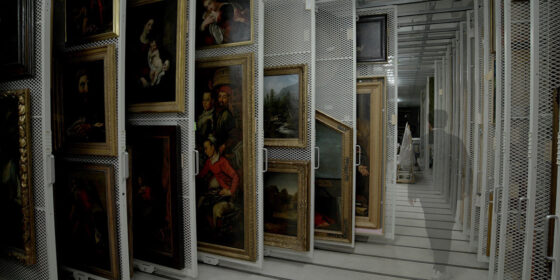TIFF 2023 | He Thought He Died (Isiah Medina, Canada) — Wavelengths

By Phil Coldiron
One frame is documentary; two is fiction.
Two frames are documentary; one is fiction.
So far as I know, film’s “Shape as Form” has yet to be written. Whenever someone gets around to adequately theorizing the functions and complications of certain industrial givens, of our wholesome and oppressive little family of rectangles, I’ll suggest that they place Isiah Medina’s He Thought He Died, which puts the term “frame” under sustained and considerable stress, in a spot near the center of their thinking.
The story here can be taken care of in the space of a few simple sentences: A Painter paints (Medina, credited as “A Painter”—the choice of article presumably matters, paints his own paintings). A filmmaker, Sam (Kelley Dong, who also shot the film alongside Medina), conducts research within the archives of a museum. Some people talk in hotel rooms. A Painter steals his paintings back from the collection of the aforementioned museum. The second and third items comprise the bulk of the film’s 70 minutes; things are not so simple.
To start with, there’s the title. Its relationship to any of the action on screen is less than obvious, but keeping entirely within terms set out by the film, I’ll offer one possibility: in shifting the temporal frame of cogito, ergo sum—we see both Pieter Nason’s portrait of Descartes and a copy of the Discourse on Method—from the active to the past tense, and in shifting its subject from the first to the third person, and in reducing its grammatical structure, it modulates philosophy into art. The varieties of possible movement between these two frames for thought has, since the beginning, animated Medina’s filmmaking.
Now, as to frames. The first composition, following the opening credits, shows a pair of hands holding a stack of photographs, seen from over the figure’s right shoulder—a classic piece of film grammar, the basic unit of the shot-reverse shot, torqued down perhaps 20 degrees—while their head blots out the left third of the frame into black negative space. The first photograph we see, monochrome and already on its way to the bottom of the stack as the shot begins, shows a number of frames, ornate and empty, arranged against a wall. There is the sound of birds, an ambient hum of atmosphere. A second photograph, again monochrome, inverts the composition in which it’s seen: it shows a view of a harbor from a balcony, with a nearby wall rendering the left side of the photograph into white negative space. The rough bristle of brush on canvas enters the soundtrack. A third monochrome photograph shows what appears to be a page of text, I suspect it’s a poem, blown out into an illegible field of gray, a dark band of shadow across its bottom edge. The figure does not linger on these images. Suddenly, we’re elsewhere: an art-shipping crate, marked LAY FLAT TO OPEN, rests atop a padded blanket. Another pair of hands enters, this time gloved and bearing a drill, and sets to work opening the box. Before they can finish, a cut to black. A flash of the first photograph, it might be a single frame, now held by other hands. And then, with the sound of scissors in action, the same space, the mess of frames against the wall, viewed directly.
This opening passage lasts roughly 12 seconds. It lays out, with Medina’s usual efficiency, the formal structure which he’ll proceed to exhaustively work through variations on. One crude way to understand this structure is as a testing of the capacities for expressiveness made available by various arrangements of framing, a verb expansive enough to include most, maybe all, of what one can do with a movie, rather than simply questions of visual composition. How do we decide what goes into a picture? Continuing on in the mode he initiated last year with the still regrettably underseen Night Is Limpid, dialogue is crucial, framed and cut with stark clarity: characters don’t exactly converse, they exchange ideas on art, politics, life, their language constantly pushing at the edges of denotation. Every frame here, taking after Pelechian, is kept as open as necessary, active and awaiting connection; the low price of this is naturalism, or obviousness, which I should think we have sufficient reserves of to last us indefinitely. There is, I have to insist, considerable wit and humour to all this, as in one delightful scene “spoken” entirely by composer Kieran Daly’s “Two-voice ha / ho / hee heterophony for synthesized speech.”
The question posed in the last paragraph is hardly a new one, or even one specific to the movies: the canvas which appears most frequently among the many seen is one by a relatively obscure Dutch painter of still lifes, Abraham Susenier: a Vanitas Still Life with a Portrait of Rembrandt, a Sculpture, a Skull, Feathers, an Overturned Roemer and a Portfolio of Drawings which conventionally, eccentrically attempts to tessellate death on a single surface. Framing the world is an activity as old as language, and I don’t think that I’m being unfair if I say that recent art has largely given up its responsibility to the refinement of this activity. In certain circles, such aspirations are even taken to be deranged.
Regarding that last word: if he thought he died, but he didn’t (no one, so far as I can tell, expires here), we might expect that would lead to institutionalization, a state that will have to be rethought. Most artists I consider serious today hate to have their pictures placed in such old-fashioned frames.
Phil Coldiron

